SsangYong Korando
The SsangYong Korando is a subcompact SUV or compact crossover SUV built by the South Korean automobile manufacturer SsangYong from 1983 to 2006 and from 2010 onwards. The name Korando is a contraction of "Korea Can Do".[1] The Korando brand is listed in the Guinness Book of Records as Korea’s longest surviving name plate.
| SsangYong Korando | |
|---|---|
 | |
| Overview | |
| Manufacturer | SsangYong |
| Production | 1983–present |
| Body and chassis | |
| Class | Subcompact SUV (J) (1983–2006) Compact crossover SUV (J) (2010–present) |
| Body style | 3-door SUV (1983–2006) 5-door crossover SUV (2010–present) |
| Layout | Front engine, rear-wheel drive / front-wheel drive / four-wheel drive |
First generation (1982–1996)
| First generation | |
|---|---|
| Overview | |
| Also called | Keohwa Korando (1983-84) Dong-A Korando (1985–87) |
| Production | 1983–84 (Keohwa Co. Ltd.) 1985–87 (Dong-A Motors) 1988-1996 (SsangYong Motors) |
| Assembly | Jurye-dong, Sasang-gu, Busan, South Korea[2] Mekong Auto, Vietnam (1991-?) |
| Body and chassis | |
| Class | Mini SUV |
| Body style | 3-door wagon Van Ambulance Pickup truck |
| Layout | Front engine, four-wheel drive |
| Powertrain | |
| Engine | Isuzu 4BA1 (diesel) Isuzu C223 (diesel) Isuzu G200Z (gasoline) Peugeot XD3P (diesel) Korean made Isuzu DC23 (diesel) |
| Dimensions | |
| Wheelbase | 2390 mm (short) 2895 mm (long) |
| Length | 3860 mm (short) 4680 mm (long) |
| Width | 1700 mm |
| Height | 1850-1900 mm |
| Curb weight | 1660-2295 kg |
In 1964, Ha Dong-hwan Motor Company began to assemble Jeeps, trucks, and buses for the US armed forces and for the United Nations Command.[3] In November 1969, the CJ-5 entered production with the 75 hp (56 kW) Willys Hurricane inline-four engine and in 1971, a ten-seater version and a pickup model were introduced. In April 1974, American Motors and Shinjin Motors formed a joint venture, Shinjin Jeep Motors, to build local Jeeps. Sold under the Asia Motors badge, military Jeeps were built (M38A1, M606) as the Asia KM410. This range eventually developed into the Asia Rocsta. The civilian CJ-5 Jeep was built as the Asia Landmaster from September 1974, with a long-wheelbase model added in 1977. These originally had a locally built AMC 258 ci straight-six engine with 110 hp (82 kW) SAE, but after the oil crises of the seventies Isuzu's 2.8-liter 4BA1 diesel engine with 85 hp (63 kW) SAE was introduced in July 1979. Troubled AMC withdrew from South Korea in August 1978. Shinjin Motors sold a shipment of Jeeps to Libya in 1979, in spite of the embargo, and this led to another ownership shakeup as it invalidated the license. Keohwa Co Ltd took over production in March 1981, and rotated the bars in the grille to minimize the resemblance to a Jeep.[4] It remained available on two wheelbases of 2,390 or 2,895 mm (94.1 or 114.0 in), with the AMC inline-six or the Isuzu 2.8-liter diesel.[3] In November 1982, the nine-seater "Family Deluxe" was introduced, and the range was renamed "Korando" in March 1983.[5]
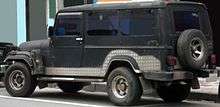
Keohwa was absorbed by Dong-A Motor in December 1984,[5] and a facelift followed in March 1985. The new model had a changed interior and the large diesel was replaced by the 2238 cc Isuzu C223 engine. The pickup version was discontinued. In June, Isuzu's 2-liter G200Z petrol engine was added. In 1986, Korandos were exported to Japan; and in 1988, SsangYong began exporting them to Europe.[5] In November 1986 Dong-A was integrated into the SsangYong Group, who changed the company's name to SsangYong Motor Company in March 1988.[5] Unlike the CJ-7, a 9-seat extended version was also available, called the Korando K9.[6] In late 1988 a new SUV on the chassis of the Isuzu Trooper was introduced, called the SsangYong Korando Family, but this car has no relation to the Jeep CJ-7 beyond the "Korando" nameplate. Production of the Jeep-based Korando ended in 1996.[7]
Second generation (1996–2006)
| Second generation | |
|---|---|
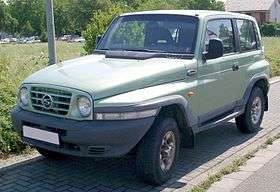 | |
| Overview | |
| Also called | Daewoo Korando SsangYong Actyon Korando (Korea, 1997–1999) TagAZ Tager[8] |
| Production | 1996–2006 (SsangYong) 1997–2005 (Mekong Auto) 2008–2014 (TagAZ)[8] |
| Assembly | Pyungtaek, South Korea Ho Chi Minh City, Vietnam Taganrog, Russia (TagAZ) Lublin, Poland Tehran, Iran |
| Designer | Ken Greenly |
| Body and chassis | |
| Class | Mini SUV |
| Body style | 3-door wagon |
| Layout | Front engine, rear-wheel drive / four-wheel drive |
| Powertrain | |
| Engine | 2.3 L M111.970/M111.974/M111.984 I4 (petrol) 3.2 L M104 I6 (petrol) 2.3 L OM601 I4 (diesel) 2.9 L OM602 I5 (diesel) |
| Dimensions | |
| Wheelbase | 2,480 mm (97.6 in) |
| Length | 4,330 mm (170 in) |
| Width | 1,840 mm (72 in) |
| Height | 1,845 mm (72.6 in) |
| Curb weight | 1,800 kg (3,968 lb) |
The second generation "New" Korando was released in Asia in 1996 to complement the SsangYong Musso (released in 1993),[9] released in Europe in 1997 and in Australia in 1998 and was based on a shortened version of the Musso's chassis.[10] The 1.8 tonne 3-door mini SUV[11] was designed by Professor Ken Greenly.[12]
It features a choice of 2.3- and 3.2-liter gasoline engines, or 2.3- and 2.9-liter diesel engines, all produced on license from Mercedes-Benz, accompanied by a five-speed manual Borg-Warner gearbox. The interior of the second generation Korando was unique because it had a steering wheel arch on either side. This was to make converting to right-hand-drive easier and to cut down on production costs. On the passenger's side, a handle was fitted in the arch.[13] This generation was sold as the Daewoo Korando from 1999 to 2001, as Daewoo bought a majority stake in SsangYong, but was later forced to sell its shares.
Revision
Production of the second generation ended in 2006. Sales however in many markets continued through to 2007 due to remaining stock. It was available with a variety of petrol and diesel engines, including a 2.9-liter five-cylinder diesel from Mercedes-Benz.[14] In 2008, Russian TagAZ, under license, began to assemble the Korando as the TagAZ Tager, not only three-door guise, but also in a specific five-door long wheelbase version.
In 2017, SsangYong previewed a concept car called the XAV Adventure, which had design features heavily inspired by the second generation of Korando.
Gallery
- Korando cabrio
 Rear view of the hardtop model
Rear view of the hardtop model The 2.9-liter Mercedes-Benz engine used in the Korando
The 2.9-liter Mercedes-Benz engine used in the Korando TagAZ Tager 3-door
TagAZ Tager 3-door- TagAZ Tager 5-door
Third generation (C200; 2010–2019)
| Third generation (C200) | |
|---|---|
_%E2%80%93_Frontansicht%2C_31._Dezember_2012%2C_D%C3%BCsseldorf.jpg) | |
| Overview | |
| Also called | SsangYong New Actyon (Kazakhstan, Russia) Micro Korando (Sri Lanka)[15] |
| Production | 2010-2019 |
| Assembly | Pyeongtaek, South Korea Vladivostok, Russia (Sollers) Kremenchuk, Ukraine (KrASZ) Polgahawela, Sri Lanka (Micro Cars)[16] Brazil: Espírito Santo (Fabral, 2014–present)[17] |
| Designer | Italdesign Giugiaro |
| Body and chassis | |
| Body style | 5-door SUV |
| Layout | Front-engine, front-wheel-drive Front-engine, four-wheel-drive |
| Powertrain | |
| Engine | 2.0 L I4 (petrol) 2.0 L I4 (diesel) 2.2 L I4 (diesel) |
| Transmission | 6-speed manual 6-speed automatic |
| Dimensions | |
| Wheelbase | 2,650 mm (104.3 in) |
| Length | 4,410 mm (173.6 in) |
| Width | 1,830 mm (72.0 in) |
| Height | 1,675 mm (65.9 in) 1,675 mm (65.9 in) |
| Curb weight | 1,537 kg (3,388.5 lb) 1,692 kg (3,730.2 lb) |

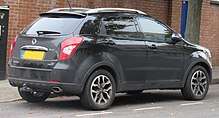
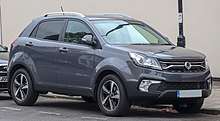
The third generation Korando, codenamed the SsangYong C200[18] began production in late 2010.[19] It is to be the first car to be released as part of SsangYong's revised lineup.[20] It has slightly longer wheelbase than its rivals, the Hyundai ix35 and Kia Sportage. The decision to name the C200 the Korando was done so by SsangYong.[21] The car will be sold in Russia as the SsangYong New Actyon.[22]
In 2013, SsangYong introduced facelift version of Korando. They re-designed front grille with new headlights include LED daytime running lamp, and rear combination lamp. In 2016, SsangYong replaced Korando's 2.0 liter diesel engine to 2.2 liter diesel engine with Euro 6 compliance. In 2017, 2nd facelift version revealed.
Features
The third generation Korando was initially released with a 6-speed manual transmission and a 6-speed M11 automatic transmission and is in production from May 2011 to 2015. Since 2015, SsangYong replaced Korando's automatic gearbox to Aisin 6-sped transmission. It is also to be offered as a front-wheel-drive or four-wheel-drive from launch. Its combined fuel consumption is 5.5 L/100 km and acceleration from 0–100 km takes less than 10 seconds.[23] The engine available upon release was a 2.0 liter turbodiesel producing 175 horsepower. Petrol engine was introduced in 2012.[24]
The Korando comes with 6 airbags as standard. The trunk capacity is 480 liters; however this can be expanded to 1300 liters when the seats are folded down.[25]
Reception
The new Korando was well received from a design perspective with many reviewers noting design improvements over previous models. Interior space too, was praised, as was the all-new monocoque chassis.
It became SUV of the year in Macedonia for 2012.
Concept models
Since 2008, five concept cars (some named C200) have been unveiled:
C200
The original concept, the C200, debuted at the 2008 Paris Motor Show[26] and has since been shown at many others. The concept received mostly positive feedback and was thought by many to be the vehicle that can turn SsangYong's reputation for having cars with questionable styling around.
C200 Aero
The concept car C200 Aero made its debut at the 2009 Seoul Motor Show. It was released one year later as Korando C with almost no modification of the original Giugiaro design.

C200 Eco
The C200 Eco made its debut at the 2009 Seoul Motor Show. It is a hybrid which uses both a diesel engine and an electric one (powered by a 340 volt battery). It also uses a stop-start system which shuts off the engine during stops. Fuel saving will be around 25%.[27] The interior features a green trim and an airy cabin.
Korando C
Launched at the 2010 Busan International Motor Show, the new Korando C concept has stayed mostly the same as the previous concepts but has more aggressive styling and is said to be a representation of the production version. Performance-wise, the new concept has a 2.0-liter turbo-diesel engine and a confirmed power output of 135 kW (184 PS; 181 hp) and 360 N⋅m (270 lb⋅ft) of torque.[21] The interior is similar to that of the C200 Eco.[28]
Fourth generation (C300; 2019–present)
| Fourth generation (C300) | |
|---|---|
.jpg) | |
| Overview | |
| Manufacturer | SsangYong |
| Production | 2019–present |
| Assembly | Pyeongtaek, Gyeonggi Province, South Korea |
| Body and chassis | |
| Body style | 5-door crossover SUV |
| Layout | Front-engine, front-wheel-drive Front-engine, four-wheel-drive |
| Powertrain | |
| Engine | 1.5 L e-XGi 150T GDI-T I4 (petrol) 1.6 L e-XDi 160 I4-T (diesel) |
| Transmission | 6-speed manual 6-speed Aisin automatic |
| Dimensions | |
| Wheelbase | 2,675 mm (105.3 in) |
| Length | 4,450 mm (175.2 in) |
| Width | 1,870 mm (73.6 in) |
| Height | 1,675 mm (65.9 in) |
| Curb weight | 1,535 kg (3,384.1 lb) 1,640 kg (3,615.6 lb) (AWD) |
.jpg)
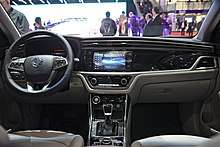
On January 28, 2019, SsangYong released a teaser image and video of the new Korando. The Korando was launched in South Korea on February 26,[31] and debuted to the global market in Geneva Motor Show 2019.[32]
The Korando is offered with a choice of 163 horsepower 1.5-liter turbo petrol or 136 horsepower 1.6-liter diesel engine and is available in two or four-wheel drive. And it is equipped with 6-speed manual transmission or 6-speed AISIN automatic gearbox.
Safety
Euro NCAP test results for a SsangYong Korando 1.6 diesel, LHD, 5-door SUV variant with standard safety equipment on a 2019 registration:
References
- "Korando Jeep Boasts Longest Production Life at 27 Years". Smotor.com. 2006-07-01. Retrieved 2012-12-01.
The name Korando was coined from combining the first three and last two letters from the motto "Korea can do."
- [Scrap] Jurye-dong Shinjin Jeep Factory ([스크랩] 주례동 신진짚차 공장)
- Cossard, Hubert. "Les "Jeep" en Corée du sud" [The "Jeeps" of South Korea]. Jeep Family (in French). Retrieved 2017-07-31.
- Redmond, Derek. "Jeeps in South Korea". CJ3B.info. Retrieved 2017-07-31.
- "History: Five decades of leadership and innovation". Ssangyong Motors. Archived from the original on 2006-05-17.
- "What's a Korando Jeep?". 4-the-love-of-jeeps.com. Retrieved 2010-05-01.
- "Korando". Koreaoto.com. Archived from the original on 2013-01-27. Retrieved 2012-12-02.
Sell time: '83.3~'95.12
- "ТагАЗ: Tagaz Tager". Tagaz.ru. Retrieved 2010-10-15.
- "Ssangyong Motors" (in Korean). Smotor.com. Archived from the original on 2004-12-22. Retrieved 2010-05-01.
- "New Ssangyong Korando Joins Off-Road Leisure Market". AUTOWEB. 1998-01-21. Archived from the original on 2011-08-07. Retrieved 2010-05-01.
- "Daewoo Korando 2.3 D mini-suv 3 doors 2.3 diesel 1999". Gnomoon.com. Archived from the original on 2015-01-14. Retrieved 2012-12-02.
- "Ssangyong Korando 4x4 tested". Wheels24.co.za. 2005-10-25. Retrieved 2012-12-02.
The Korando was designed by Professor Ken Greenley of the Royal College of Art in London, using the WW2 Willy's Jeep as his basic theme.
- "Daewoo Korando 4WD". Ebroadcast.com.au. Archived from the original on 2008-09-29. Retrieved 2010-05-01.
- "SsangYong / Korando / SX 5-dr wagon". GoAuto.com.au. Retrieved 2011-04-10.
- "Micro Korando". Micro Cars (Pvt) Ltd. 2015. Archived from the original on 28 March 2015.
- "Presenting the 1st Korando SUV at Temple Trees, to His Excellency The President Mahinda Rajapakse". Micro Cars Limited. 2011-02-21. Archived from the original on 2011-09-02. Retrieved 2011-09-16.
- "Fabral assina protocolo de intenção de fábrica no espírito santo" [Fabral signs factory protocol of intent on holy spirit] (in Portuguese). SsangYong Brazil. Archived from the original on 17 July 2013.
- Moon Gwang-lip (2008-04-25). "INSIDE JoongAng Daily". Joongangdaily.joins.com. Retrieved 2010-05-01.
- Moon Gwang-lip & Park Yeong-wung (2010-03-02). "INSIDE JoongAng Daily". Joongangdaily.joins.com. Retrieved 2010-05-01.
- "SsangYong C200 Concept (2008) with pictures and wallpapers". Netcarshow.com. Retrieved 2010-05-01.
- GoAutoMedia. "SsangYong 2010 Korando - Busan show: SsangYong Korando reborn". GoAuto. Retrieved 2010-05-01.
- "Ssangyong Korando C To Be Renamed 'New Actyon' by Sollers". Insideline.com. 2010-09-09. Retrieved 2010-10-15.
- ""Автоцентр" протестировал новый SsangYong Korando". Autocentre.ua. Retrieved 2010-10-15.
- "175 pk diesel voor SsangYong Korando, AutoTelegraaf.nl nieuws". Autotelegraaf.nl. 2010-09-23. Retrieved 2010-10-15.
- Sergio Piccione (2010-09-23). "SsangYong Korando: llega una nueva era". ELOMUNDO.es. Retrieved 2010-09-25.
- "SsangYong C200 Concept breaks tradition". CarAdvice. 2008-09-13. Retrieved 2010-05-01.
- Navarro, Xavier (2008-03-11). "Geneva 08: More on SsangYong's hybrid system". Autoblog green. Retrieved 2010-05-01.
- por Alberto Ballestin de 29 de Apr del 2010. "SsangYong muestra el nuevo Korando (todavía conceptual)". Es.autoblog.com. Archived from the original on 2010-05-03. Retrieved 2010-05-01.
- "대한민국 교통 포털:::교통신문:::". Gyotongn.com. Retrieved 2010-05-01.
- CofinaMedia Internet (2010-05-01). "Automotor". News.automotor.xl.pt. Retrieved 2010-10-15.
- 최경애 (2019-02-26). "(LEAD) SsangYong launches Korando SUV to boost sales". Yonhap News Agency. Retrieved 2019-04-28.
- "Ssangyong launches its all-new Korando for Europe at Geneva | Automotive World". Retrieved 2019-04-28.
- . Euro NCAP https://www.euroncap.com/en/results/ssangyong/korando/38099. Retrieved 4 September 2019. Missing or empty
|title=(help)